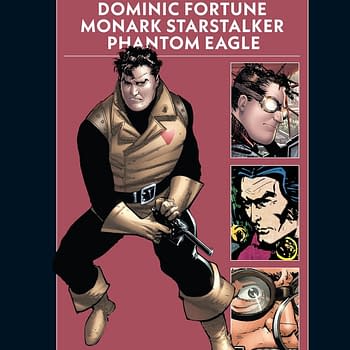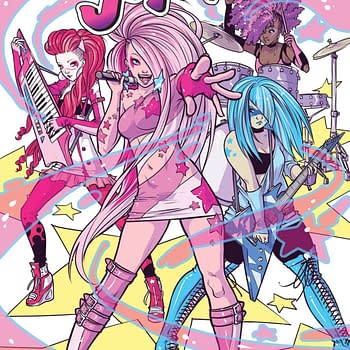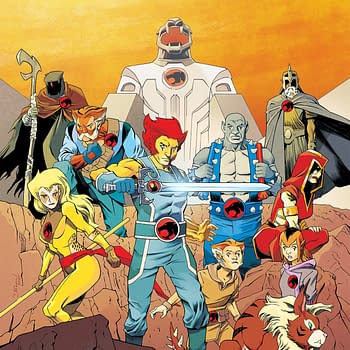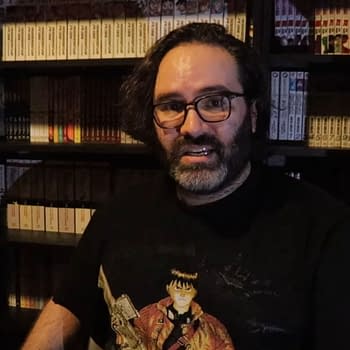Posted in: Comics | Tagged: Comics, david liss, dynamite, entertainment, green hornet, ken lashley, Kewber Baal
Writer's Commentary – David Liss Talks Finale Of The Green Hornet: Reign Of The Demon
Dynamite has sent us a writer's commentary by David Liss on Green Hornet: Reign of the Demon #4, the grand finale, that is on sale now. Cover by Ken Lashley and interiors by Kewber Baal.
Page 1-2:
I always invest a lot of thought into how to end an issue and then resume the story. Generally I avoid ending an issue with a character-in-danger plotline. If the survival or safety of the character isn't really a question, then asking the reader to wonder if the character will survive tends to be a bust. In this case, the issue isn't so much that Green Hornet is in danger of being caught – that's always the case. The issue is that after making a huge blunder at the end of the previous issue – that is, accusing Cline of being the Swashbuckler and then discovering the depth of his mistake – the Green Hornet has pissed off every cop in the city and for no good reason. The question is not will Hornet get away but how he gets away and what price will he pay for his error.
Page 3:
Up until this issue, the Hornet hasn't known what to make of the Swashbuckler – is he good or bad, admirable or a buffoon? Now things are finally turning. Swashbuckler comes to the Hornet's rescue, and like it or not, they are on the same path.
Page 4:
Kato reveals that he made good use of Britt's mistake by attaching a transmitter to Cline's car. Swashbuckler's comment that Kato is the brains of their operation comes across as a friendly jibe, but it is also an opportunity to emphasize just how Kato and GH are different. I see the Hornet as more impulsive and Kato as more strategic.
Page 5:
The last panel on the page reveals the huge number of mutilated, brainwashed victims. We've dropped hints before, but now we get a sense of the scope of what Demone is up to.
Page 6:
This story has always been about two hero camps (Hornet and Swashbuckler) set against two villain camps (Demone and Cline), even if the reader hasn't always been in on who's who. Now that it's all out in the open, I felt like it was time for the inevitable conflict between villains. These guys may work together, but they don't have the same goals, and creating these sorts of conflicts is always fun. I love when villains realize they can't trust one another. Cline clearly thought he could control Demone, but now sees he's playing with fire. Demone isn't just bad, he's nuts.
Page 7:
Now that the heroes know who the bad guys are, they need another challenge to keep the stakes high. In this case, it's the realization that the brainwashed attackers are victims not villains, and that means they can't just mow them down. So how to deal with an enemy who is not responsible for what they're doing?
Page 8:
Hornet goes to see Gareri, and I thought it might be kind of obvious that Gareri always seems to be where the Hornet wants to find him. I turned it into a joke, which is hopefully funny once the reader gets to the reveal at the end.
Pages 9- 10:
This is where the two hero camps finally come together, no longer doubting each other. It's also where I found a use for Britt owning a radio station.
Page 11:
We have transitioned into end game. Cline is burning bridges. The attack begins in earnest. There's now a hint of desperation, which is always fun to write.
Page 12:
When I first started writing comics, I hated doing splash pages. I saw them as giving up precious story-telling panels. Some editors leaned on me to do them, and I eventually came to understand the story-telling power of the big panel. When I do use them, I like for them to come in transitional moments like this one, in which something major is shifting. It was also a great way to convey how the police are overwhelmed by the numbers of the brainwashed. Kewber does an amazing job of filling the panel with chaos and tension.
Page 13:
Twice before in the story I had Hornet use his electroshock gun against enemies who have figured out a way to protect themselves. I figured I needed a third try – one that works.
Page 14:
Hornet sets himself up as a decoy, reluctantly following Swashbuckler's plans. He's almost disappointed that the plan is working, but since there have been some conflicts over this storyline about Britt not being comfortable with following teammates' leads, this seemed like a good place to show he's gotten the message and is at least trying to change.
Page 15:
I loved the idea of the top cop walking through the police station proclaiming he's not a policeman.
Pages 16-17:
And, of course, I could not resist the dark twist of having the arrogant Cline be destroyed by his own plan. The decision to have him set upon is morally ambiguous, so I decided to let Swashbuckler be the one to make the call. It lets Hornet off the hook. I'm also building the Travis plotline here. On the Green Hornet radio show, she figures out the Hornet's secret identity, so this is a plotline for the serious fans.
Page 18:
I decided to leave Demone uncaptured in part because I dislike neat endings and in part because it would have felt too rushed and too easy to bring both these guys down in one issue. It also seemed like a good idea to leave a few elements unresolved in case I had the chance to continue with the story.
Page 19:
And then, of course, there is the Gareri reveal. He was always such an over-the-top immigrant caricature that some readers must have suspected this.
Page 20:
And, finally, I wanted to end on an exciting note, so this seemed like a good place for Linda Travis to reveal what she's figured out. When I started this story, I was dealing with a continuity that Mark Waid had seriously changed. I had to deal with the story elements he set in motion. I figured it was only fair to pass on some chaos to the next writer.



















